News
Decarbonising Non-Residential, Public and Commercial Buildings Webinar Summary
Decarbonising Non-Residential, Public and Commercial Buildings Webinar Summary
On the 4th of February 2025, Sureserve hosted a webinar dedicated to decarbonising Non-Residential, Public and Commercial Buildings. Led by Andrew Tod, Head of Net Zero Carbon at Sureserve, Michael Firth, Business Development Manager at CorEnergy (part of Sureserve), and Darren Harper, Commercial Director at CorEnergy, the session provided a roadmap for organisations aiming to transition to net zero. It explored real-world solutions, best practices, and funding mechanisms while addressing the challenges of the energy transition.
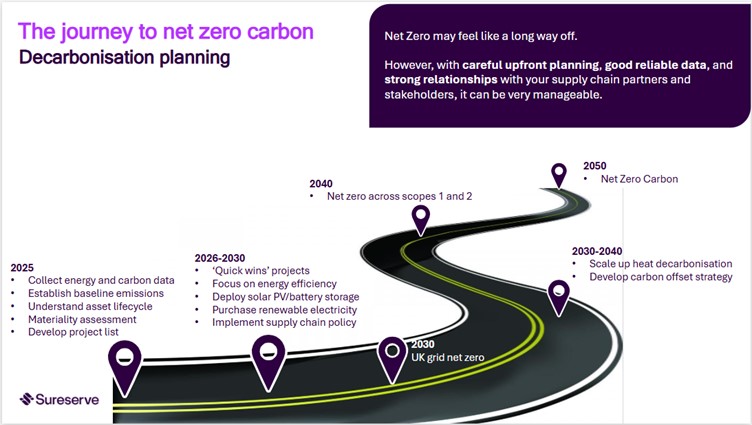
A Significant Challenge and Opportunity
According to the UK Gov Non-domestic National Energy Efficiency Data-Framework (ND-NEED) 2023, non-domestic buildings in England and Wales account for considerable energy consumption, using 156 TWh of gas and 122 TWh of electricity annually. Andrew Tod explained, these buildings represent an essential area of focus for decarbonisation, given their energy intensity and carbon footprint.
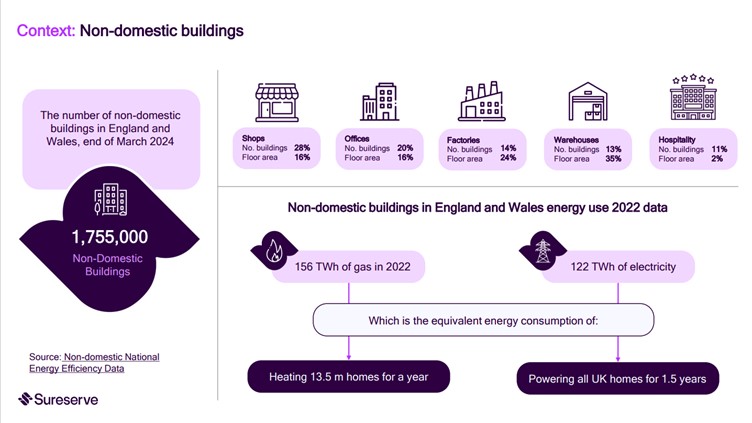
Breaking down energy consumption by sector, factories lead in electricity use, followed by offices, shops, and warehouses. However, when viewed through the lens of energy intensity (energy consumed per square meter), hospitality emerges as the most energy-intensive sector, followed by shops and healthcare. These insights underscore the urgency of implementing energy-efficient and renewable solutions across all sectors, particularly in highly energy-intensive environments like the NHS, which has committed to achieving net-zero emissions across its carbon footprint by 2040.
Solar PV: A Cornerstone Technology
Michael Firth highlighted solar photovoltaic (PV) systems as a cornerstone of decarbonisation strategies, describing them as "always at the forefront of every business's mind." Solar PV allows organisations to generate renewable electricity on-site, reducing grid reliance and protecting against market volatility. He outlined how Sureserve is leading solar PV installations across non-residential, public and commercial sites, helping organisations maximise available roof space, reduce energy bills, and cut carbon emissions.
One standout example discussed during the webinar was the Victory Leisure Centre in Norfolk, where a solar PV installation funded by an external grant is now generating 188,000 kWh annually, equivalent to powering 70 homes per year. However, Michael stressed that deploying solar PV at scale requires addressing grid constraints and ensuring roofs are in good structural condition to handle the load.
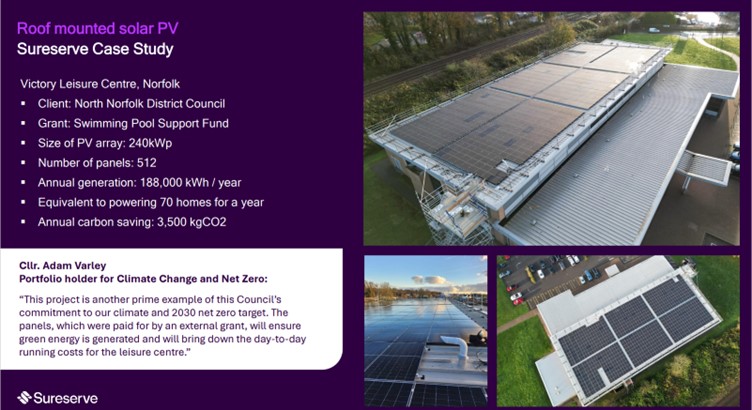
Heat Pumps: The Future of Low-Carbon Heating
Air source heat pumps are increasingly recognised as a key technology in efforts to achieve decarbonisation. They play a critical role in reducing on-site gas consumption, offering organisations a practical solution to advance their decarbonisation strategies. At present, air source heat pumps are the preferred choice for heat decarbonisation, due to their high energy efficiency performance. Heat pumps are suitable for offices, hospitals, universities, schools, leisure centres, stadiums, warehouses, manufacturing sites, hotels, agricultural buildings, car parks, data centres, and retail units. Detailed site assessment and careful design against a building’s heat loads is required.
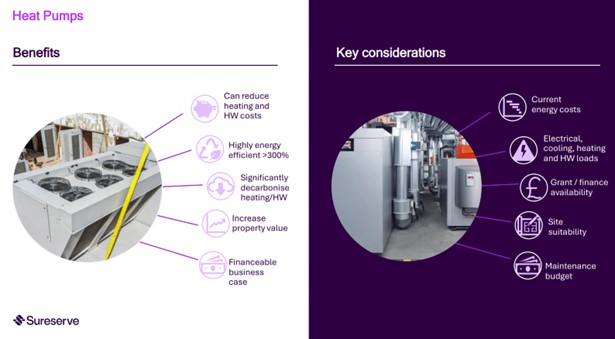
The primary benefits of air source heat pumps include their ability to lower heating and hot water costs while achieving high energy efficiency levels. This is measured through the coefficient of performance (COP), which calculates the number of kilowatts of electricity required to generate a certain amount of heat.
Scaling up heat pump installations involves addressing key considerations, such as assessing current energy costs, evaluating heating and cooling loads, exploring grant or financing options, ensuring site suitability, and planning for ongoing maintenance budgets. These factors ensure the system functions effectively while achieving its carbon and cost-saving objectives.
One of the case studies shared during the webinar was the M&S Bank Arena in Liverpool, where a 200 kW air source heat pump replaced a gas-fired hot water system, leading to a 75% reduction in energy consumption and an 83% decrease in carbon emissions.
At Widnes Vikings Stadium, the installation of 14 air source heat pumps replaced gas boilers, cutting 136 tonnes of CO₂ emissions per year. These projects demonstrate how strategic investment in low-carbon heating can significantly reduce energy demand and environmental impact.
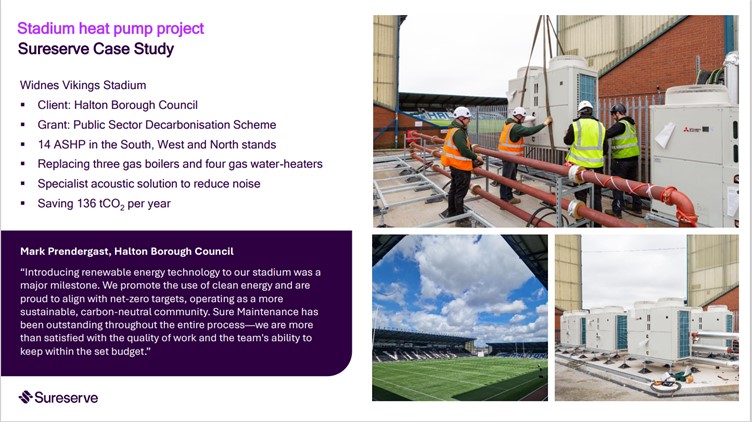
Best Practice in Design, Installation, and After-Care
Effective decarbonisation projects rely on thoughtful design, precise installation, and consistent after-care. During the webinar, the speakers emphasised the importance of tailoring system design to match a building’s energy needs, avoiding oversizing to reduce waste, and maximising efficiency. High-quality products with long warranties and compliance with safety standards were also highlighted as essential for ensuring longevity and performance.
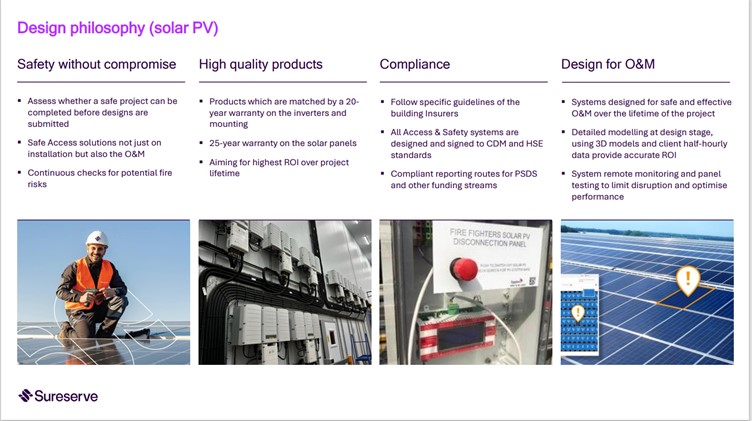
After installation, proper maintenance plays a vital role. Regular inspections, cleaning, and checks for wear are necessary to maintain optimal performance, with remote monitoring providing valuable insights year-round. These practices ensure that systems not only meet but exceed their intended carbon reduction and cost-saving goals. Michael Firth emphasised the importance of a strategic roadmap, stating that “Decarbonisation is not about one-off projects. It’s about creating a fully integrated, long-term plan that ensures buildings remain energy efficient for decades to come.”
Funding and contracting options
Accessing funding was a recurring theme throughout the webinar. Both speakers encouraged organisations to take advantage of government grants like the Public Sector Decarbonisation Scheme (PSDS). However, they warned that securing funding requires thorough preparation, including feasibility studies, detailed designs, and early engagement with suppliers.
Michael Firth summed it up: “If you want to be ready for funding windows, you need to start planning now. Don’t wait until the last minute. Engage with trusted partners who can help you navigate the process and deliver on your goals.”
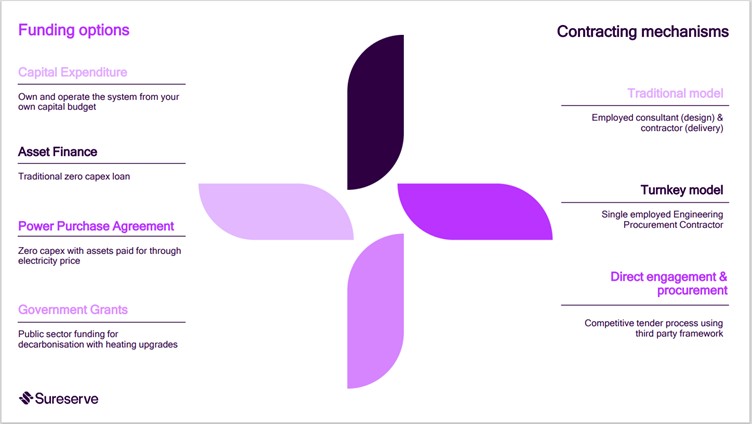
If you'd like to watch the recorded webinar and explore the insights shared by our experts, please follow this link or get in touch with us directly to speak to one of our specialists. We’re here to help guide you on your journey to decarbonisation.
Post
-

Sureserve Urges Government to Fund Warm Homes Plan
27 May 2025
-

Sureserve Is Pleased To Announce
22 May 2025
-

Apprentices showcase their skills
10 Apr 2025
-

Warm Homes Fund: A Significant Opportunity for Retrofit in the Housing Sector
18 Mar 2025
-

Sureserve Welcomes £1.8BN Boost to Warm Home Plan
13 Mar 2025